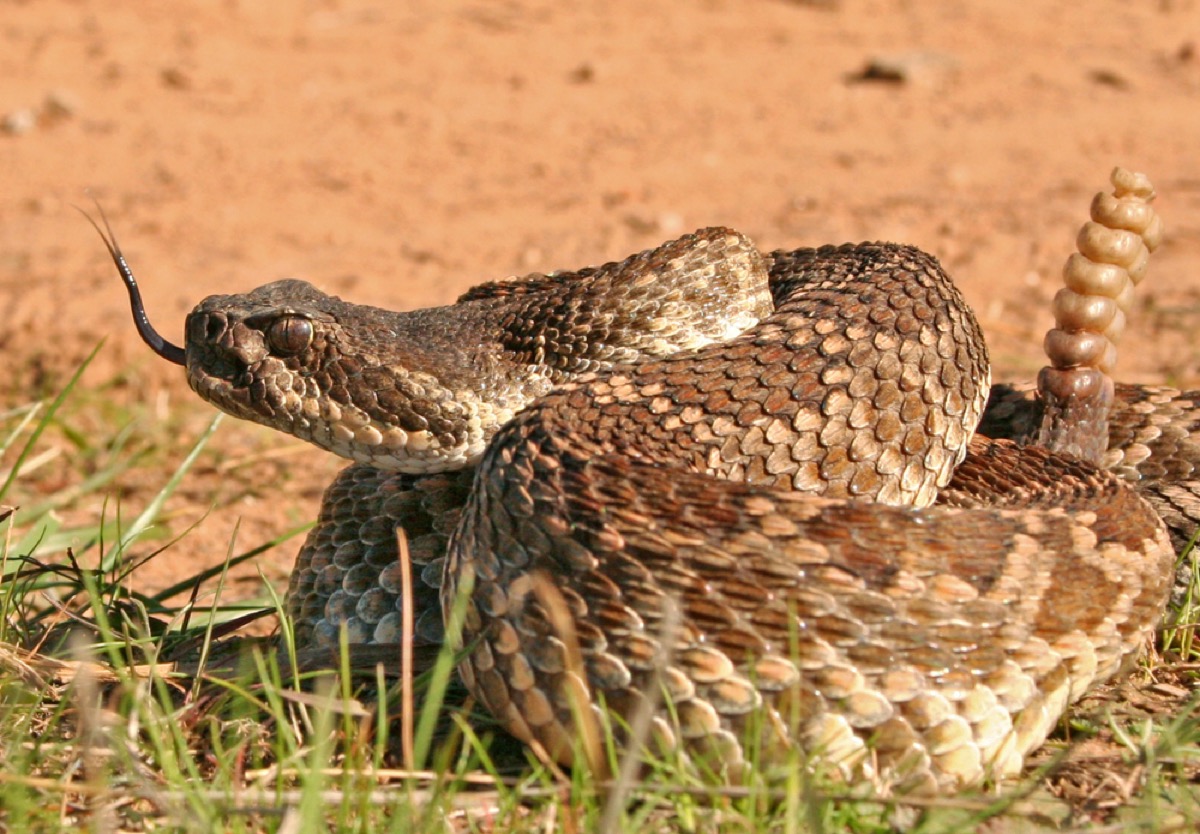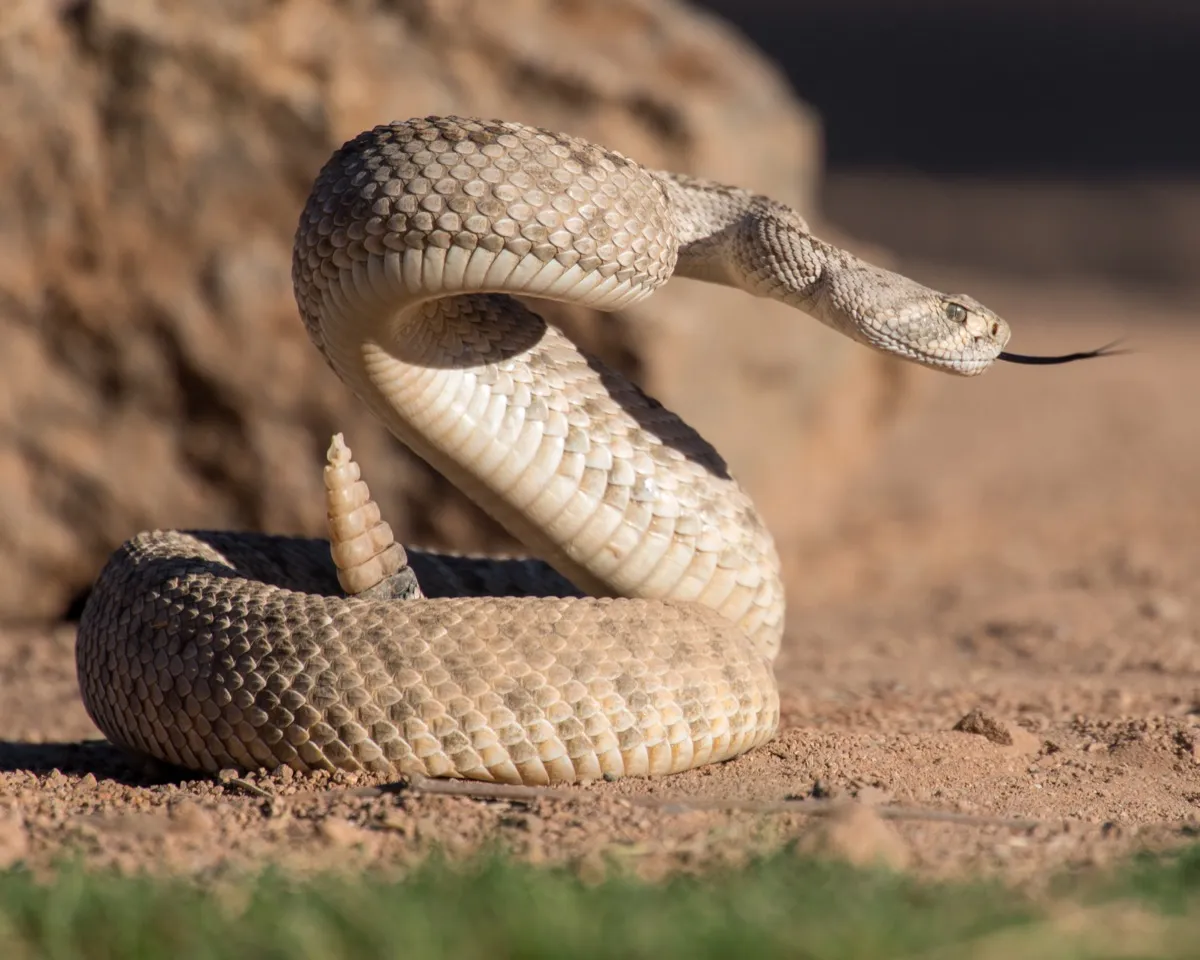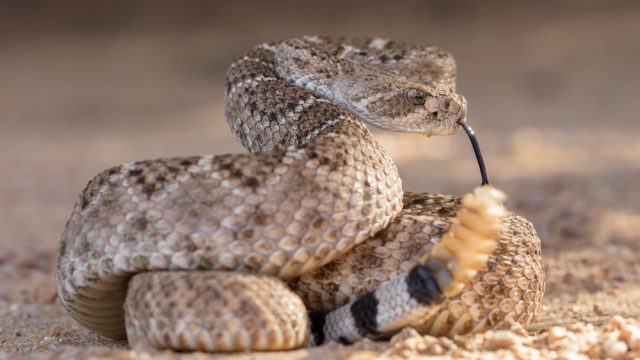If You Live Here, Prepare to See More Rattlesnakes This Month, Experts Say
A combination of weather conditions could bring the reptiles out in greater numbers.
No matter where you live in the U.S., snakes are a part of the natural environment. Unfortunately, they tend to have an undeserved bad reputation even though they play an absolutely vital role in the ecosystem that can ultimately benefit your yard. But because some species are venomous, it's essential for people in certain states to be aware of their surroundings and to take care not to disturb any snakes they may come across on their property or out in the wild. And now, experts are warning that one particular area could be about to see more rattlesnakes than usual. Read on to see which place might have an increase in reptile sightings in the coming weeks.
READ THIS NEXT: The No. 1 Sign There's a Snake in Your Yard, Experts Say.
If you live in a rattlesnake area, stay alert and know how to avoid them.

In terms of venomous snakes, it's hard to think of a more recognizable species than the rattlesnake. Fortunately, the quick shaking sounds their tails produce, which give them their name, can also serve as an early warning other types of reptiles don't provide.
If you live in an area where rattlesnakes are common, consider wearing boots and long pants on hikes to help protect against any unexpected encounters, experts at the University of California, Davis suggest. It's also best to avoid unmarked trails, tall weeds, and underbrush where snakes may hide from predators and extreme temperatures. And since most rattlesnake bites occur between April and October, when the weather is warm, it's best to stay alert when performing yard work or enjoying the outdoors. Keep an eye out for potential hiding spaces and listen for their telltale warning rattle.
But if you live in one area, you might want to take extra rattlesnake precautions in the coming weeks.
One state might soon see an increase in rattlesnakes.

Extreme weather patterns can bring all kinds of things to the areas they hit, whether it's flooding from rains or wildfires brought on by a lack of them. But experts in New Mexico are warning that an increase in precipitation will likely bring more rattlesnakes to the state in the coming months.
"Usually lots of rain creates a lot of foliage," snake catcher Tom Wyant told the Santa Fe New Mexican. The extra plant life "brings out more rabbits, which multiply, and rodents and packrats, and that could be the reason we are seeing more rattlesnake activity—because of the food source."
In addition to a particularly wet summer in New Mexico, temperatures have also been high, affecting rattlesnakes' behavior. "When it warms up, that brings them out, gets them in the sun and more active to do whatever they need to," Wyant said.
For more pest alerts sent right to your inbox, sign up for our daily newsletter.
Certain weather conditions can increase snake activity—including bites.

According to the New Mexico Poison and Drug Information Center, August is already considered the high season for rattlesnakes, per the New Mexican. And in addition to fertile vegetation providing more prey, heavy rains have also created flooding conditions that can cause the reptiles to flee their usual surroundings and come to areas inhabited by humans.
"The potential for human/pet/snake encounters likely increases with increased snake and human activity during the summer months," Samuel T. Smallidge, a wildlife extension specialist with New Mexico State University, wrote in an email to the New Mexican, citing a 2020 report from the Journal of Environmental and Public Health. "There is some evidence that increased incidence of snakebites following flooding events does occur."
However, there may be some reason to believe that an especially wet season might not only have immediate effects on snake numbers. According to a study conducted from 1997 to 2017 by Stanford Health Care and the University of Colorado, any 10 percent increase in rainfall in the previous 18 months coincided with a four percent increase in snake bites across all counties in California, per the New Mexican.
While the report suggests there is "a really strong association—almost a predictor—of snake bites based on weather and the climate," Grant Lipman, MD, one of the study's researchers and an emergency medicine specialist, told the New Mexican that it could be a trickle-down effect. He theorizes that since increased rainfall forces snakes to be more active, it could in turn lead to increased mating that brings about "a larger snake population, which would then go on to bite people."
Here's how to avoid a close encounter with a rattlesnake.

If you're looking to avoid run-ins with rattlesnakes, the best way to prevent an injury is to simply leave them alone—whether or not you live in New Mexico. "In the prototypical bite, somebody is trying to poke at the snake or irritate it," Brandon Warrick, MD, acting medical director for the New Mexico Poison and Drug Information Center, told the New Mexican.
Even if you share a habitat with rattlesnakes, there are ways you can cut down your chances of coming across one on your property. "You can modify the environment around your home by removing potential snake shelters—usually cool, damp hiding places—and food sources, such as rodents," experts at the New Mexico State University write. They also suggest keeping lawns well mowed and free of debris or rockpiles that could be used as a hiding space and keeping low-growing shrubs trimmed to at least one foot above the ground. You should also stack any firewood away from your home on a rack that elevates it at least one foot off of the ground.
If you end up accidentally bitten, Warrick says it's essential to call 911 immediately and seek medical attention as soon as possible. You should also remove any jewelry or clothing that could be affected by swelling. However, you should never apply a tourniquet or cut the wound to suck out the venom.






















